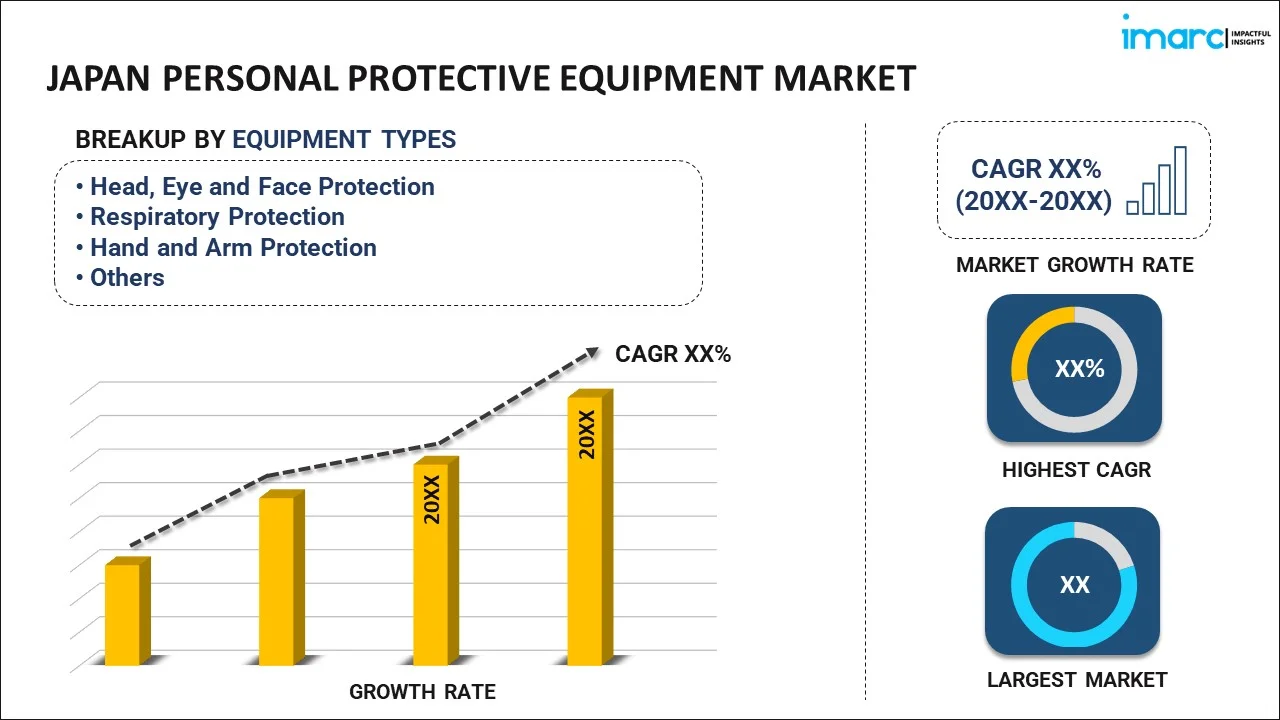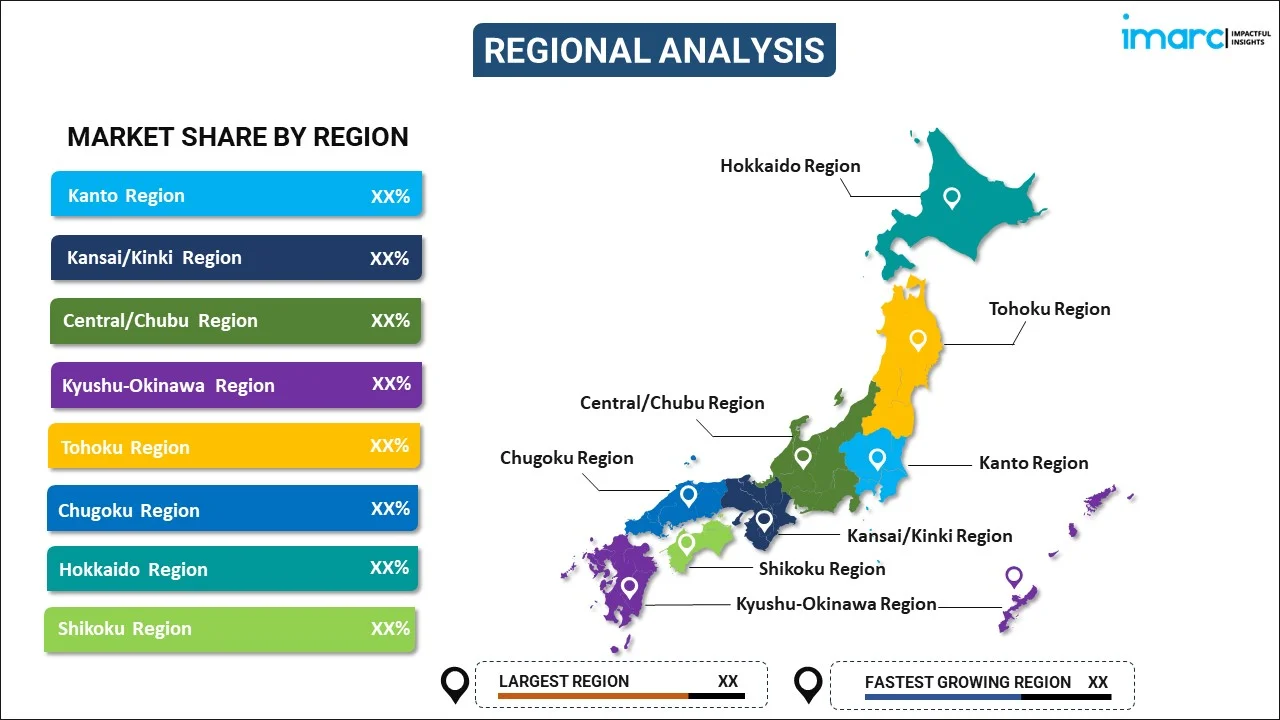
Japan Personal Protective Equipment Market Report by Equipment Type (Head, Eye and Face Protection, Respiratory Protection, Hand and Arm Protection, Protective Clothing, Fall Protection, Protective Footwear, Hearing Protection, and Others), End Use Industry (Oil and Gas, Construction, Chemical, Healthcare, Manufacturing, and Others), and Region 2025-2033
Market Overview:
Japan personal protective equipment market size reached USD 4,795.0 Million in 2024. Looking forward, IMARC Group expects the market to reach USD 23,378.0 Million by 2033, exhibiting a growth rate (CAGR) of 19.2% during 2025-2033. The increasing innovations in material and design of personal protective equipment, including the development of smart features like integrated sensors and communication devices, are primarily driving the market.
|
Report Attribute
|
Key Statistics
|
|---|---|
|
Base Year
|
2024 |
|
Forecast Years
|
2025-2033
|
|
Historical Years
|
2019-2024
|
| Market Size in 2024 | USD 4,795.0 Million |
| Market Forecast in 2033 | USD 23,378.0 Million |
| Market Growth Rate (2025-2033) | 19.2% |
Personal protective equipment (PPE) refers to specialized gear and clothing worn to safeguard individuals from workplace hazards or infectious agents. PPE is designed to minimize the risk of injury or illness by creating a barrier between the wearer and potential threats. Common PPE items include helmets, gloves, safety goggles, respirators, face shields, aprons, and coveralls. In industrial settings, PPE is crucial for protecting workers from various dangers such as chemical exposure, falling objects, or loud noise. In healthcare, PPE is essential for safeguarding healthcare professionals and patients from the transmission of diseases. Proper selection, use, and maintenance of PPE are vital to ensure its effectiveness. Workers should be trained on how to wear and handle PPE correctly to maximize safety. PPE not only shields individuals from harm but also contributes to a safer and healthier working environment.
Japan Personal Protective Equipment Market Trends:
The personal protective equipment market in Japan is witnessing robust growth due to several key drivers. Firstly, heightened awareness of occupational safety and health regulations has propelled demand for PPE across various industries. Moreover, stringent government mandates and regulations mandating the use of PPE in hazardous work environments have been instrumental in driving market expansion. Additionally, the ongoing health crisis has underscored the critical importance of protective gear, leading to its increased adoption not only in healthcare settings but also in everyday life, including workplaces, schools, and public spaces. This surge in demand for PPE products like masks, gloves, and face shields has driven market growth. Furthermore, technological advancements have played a pivotal role in enhancing the PPE market. Innovations in materials and design have resulted in more comfortable and effective protective gear, increasing its acceptance among users. Apart from this, the integration of IoT and smart technologies into PPE that provide real-time monitoring and data collection capabilities is expected to drive the personal protective equipment market in Japan during the forecast period.
Japan Personal Protective Equipment Market Segmentation:
IMARC Group provides an analysis of the key trends in each segment of the market, along with forecasts at the country level for 2025-2033. Our report has categorized the market based on equipment type and end use industry.
Equipment Type Insights:

- Head, Eye and Face Protection
- Respiratory Protection
- Hand and Arm Protection
- Protective Clothing
- Fall Protection
- Protective Footwear
- Hearing Protection
- Others
The report has provided a detailed breakup and analysis of the market based on the equipment type. This includes head, eye and face protection, respiratory protection, hand and arm protection, protective clothing, fall protection, protective footwear, hearing protection, and others.
End Use Industry Insights:
- Oil and Gas
- Head, Eye and Face Protection
- Respiratory Protection
- Protective Clothing
- Hand and Arm Protection
- Protective Footwear
- Fall Protection
- Hearing Protection
- Others
- Construction
- Head, Eye and Face Protection
- Respiratory Protection
- Protective Clothing
- Hand and Arm Protection
- Protective Footwear
- Fall Protection
- Hearing Protection
- Others
- Chemical
- Head, Eye and Face Protection
- Respiratory Protection
- Protective Clothing
- Hand and Arm Protection
- Protective Footwear
- Others
- Healthcare
- Head, Eye and Face Protection
- Respiratory Protection
- Protective Clothing
- Hand and Arm Protection
- Others
- Manufacturing
- Head, Eye and Face Protection
- Respiratory Protection
- Protective Clothing
- Hand and Arm Protection
- Protective Footwear
- Fall Protection
- Hearing Protection
- Others
A detailed breakup and analysis of the market based on the end use industry have also been provided in the report. This includes oil and gas (head, eye and face protection, respiratory protection, protective clothing, hand and arm protection, protective footwear, fall protection, hearing protection, and others), construction (head, eye and face protection, respiratory protection, protective clothing, hand and arm protection, protective footwear, fall protection, hearing protection, and others), chemical (head, eye and face protection, respiratory protection, protective clothing, hand and arm protection, protective footwear, and others), healthcare (head, eye and face protection, respiratory protection, protective clothing, hand and arm protection, and others), manufacturing (head, eye and face protection, respiratory protection, protective clothing, hand and arm protection, protective footwear, fall protection, and hearing protection), and others.
Regional Insights:

- Kanto Region
- Kansai/Kinki Region
- Central/ Chubu Region
- Kyushu-Okinawa Region
- Tohoku Region
- Chugoku Region
- Hokkaido Region
- Shikoku Region
The report has also provided a comprehensive analysis of all the major regional markets, which include Kanto Region, Kansai/Kinki Region, Central/ Chubu Region, Kyushu-Okinawa Region, Tohoku Region, Chugoku Region, Hokkaido Region, and Shikoku Region.
Competitive Landscape:
The market research report has also provided a comprehensive analysis of the competitive landscape. Competitive analysis such as market structure, key player positioning, top winning strategies, competitive dashboard, and company evaluation quadrant has been covered in the report. Also, detailed profiles of all major companies have been provided.
Japan Personal Protective Equipment Market Report Coverage:
| Report Features | Details |
|---|---|
| Base Year of the Analysis | 2024 |
| Historical Period | 2019-2024 |
| Forecast Period | 2025-2033 |
| Units | Million USD |
| Scope of the Report | Exploration of Historical and Forecast Trends, Industry Catalysts and Challenges, Segment-Wise Historical and Predictive Market Assessment:
|
| Equipment Types Covered | Head, Eye and Face Protection, Respiratory Protection, Hand and Arm Protection, Protective Clothing, Fall Protection, Protective Footwear, Hearing Protection, Others |
| End Use Industries Covered |
|
| Regions Covered | Kanto Region, Kansai/Kinki Region, Central/ Chubu Region, Kyushu-Okinawa Region, Tohoku Region, Chugoku Region, Hokkaido Region, Shikoku Region |
| Customization Scope | 10% Free Customization |
| Post-Sale Analyst Support | 10-12 Weeks |
| Delivery Format | PDF and Excel through Email (We can also provide the editable version of the report in PPT/Word format on special request) |
Key Questions Answered in This Report:
- How has the Japan personal protective equipment market performed so far and how will it perform in the coming years?
- What has been the impact of COVID-19 on the Japan personal protective equipment market?
- What is the breakup of the Japan personal protective equipment market on the basis of equipment type?
- What is the breakup of the Japan personal protective equipment market on the basis of end use industry?
- What are the various stages in the value chain of the Japan personal protective equipment market?
- What are the key driving factors and challenges in the Japan personal protective equipment?
- What is the structure of the Japan personal protective equipment market and who are the key players?
- What is the degree of competition in the Japan personal protective equipment market?
Key Benefits for Stakeholders:
- IMARC’s industry report offers a comprehensive quantitative analysis of various market segments, historical and current market trends, market forecasts, and dynamics of the Japan personal protective equipment market from 2019-2033.
- The research report provides the latest information on the market drivers, challenges, and opportunities in the Japan personal protective equipment market.
- Porter's five forces analysis assist stakeholders in assessing the impact of new entrants, competitive rivalry, supplier power, buyer power, and the threat of substitution. It helps stakeholders to analyze the level of competition within the Japan personal protective equipment industry and its attractiveness.
- Competitive landscape allows stakeholders to understand their competitive environment and provides an insight into the current positions of key players in the market.
Need more help?
- Speak to our experienced analysts for insights on the current market scenarios.
- Include additional segments and countries to customize the report as per your requirement.
- Gain an unparalleled competitive advantage in your domain by understanding how to utilize the report and positively impacting your operations and revenue.
- For further assistance, please connect with our analysts.
 Inquire Before Buying
Inquire Before Buying
 Speak to an Analyst
Speak to an Analyst
 Request Brochure
Request Brochure
 Request Customization
Request Customization




.webp)




.webp)












